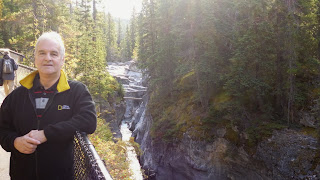After the fantastic experience of walking on the Glacier we continued our journey along the Icefields Parkway spending a little time at
Athabasca Falls,
a waterfall
on the upper Athabasca River, approximately 30 kilometres south of the townsite of Jasper.
A powerful, picturesque waterfall, Athabasca Falls is not known so much
for the height of the falls (23 metres), as it is known for its force
due to the large quantity of water falling into the gorge.
We continued our journey to
Jasper and our hotel for two nights Chateau Jasper.
After quickly unpacking a few items we ventured further into Jasper to get something to eat before retiring for the night.
There are some lovely buildings in Jasper, a church,
and individually styled houses,
beautiful scenery,
a totem pole,
and an old steam engine.
The following morning was crisp and a little cold so we wrapped up and boarded the coach for a trip to
Maligne Canyon, a natural feature eroded out of the
Palliser Formation, the canyon measures over 50 metres (160 ft) high.
Flowing out of Medicine Lake, the Maligne River
flows about 15 kilometers upstream as a full size river, but very
quickly disappears seeping into the ground and completely vanishes from
the surface not far from the lake for most of the year.
The smaller
streams that feed the valley below that point rebuild the river by the
time it reaches the top of the canyon.
Our next stop was Medicine Lake,
a geologic anomaly in the sense that it is not actually a lake but rather an area in which the Maligne River
(flowing from Maligne Lake
into the Athabasca River) backs up and suddenly disappears underground. During the summer months during intensified meltwater runoff
the lake (which during the winter months is a meandering frozen river)
fills to levels which fluctuate over time and with the runoff events.
Much like a bathtub that is filled too fast for it to drain, it becomes
laden with water (lake) until it can slowly drain as the tap flow
(runoff) is reduced (river).
The underground system is extensive and
during the 1970s researchers used a biodegradable
dye to determine the underground river's extent. The dye showed up in
many of the lakes and rivers in the area to the point where it became
clear that the underground system was one of the most extensive in the
world.
Next we went to the breathtaking
Maligne Lake, famed for the colour of its water
the surrounding peaks, the three glaciers visible from the lake
and
Spirit Island, one of the most photographed locations in the world. Maligne Lake takes its name from the French word for malignant or wicked. The name was used by Father Pierre-Jean De Smet
(1801–1873) to describe the turbulent river that flows from the lake
(in the spring), and soon spread to the lake, canyon, pass, mountain and
range. It is also possible that early French traders applied the name
to the river for its treacherous
confluence with the Athabasca River.
We had a cruise on the lake to look forward to, so we purchased some sandwiches and a soft drink from the restaurant to take with us, then took our boat ride to the island. The next photographs were taken from there.
I think you will agree it is beautiful and can understand why is is photographed so much, to say we were in awe of the scenerey is a gross understatement.
Being, by now, late afternoon, it was time to board the coach once again to return to the hotel where we just had time to freshen up and change before joining our fellow guests on the tour for a complimentary dinner at the hotel. After dinner we were treated to a very interesting talk by a local wildlife expert. Everyone retired reasonably early as we had to be at the station in Jasper for 8.30 the following morning to take the next exciting leg of our journey, one which had really been the deciding factor, for us, when booking the holiday.
Join me next time for Canada Part 4 and The Rocky Mountaineer!





























































